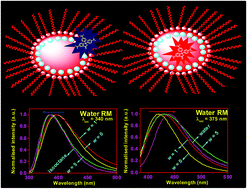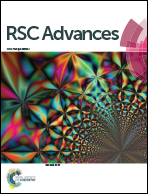Photophysics of crystal violet lactone in reverse micelles and its dual behaviour†
Abstract
In this article, the photophysics of Crystal Violet Lactone (CVL) in aqueous and non-aqueous reverse micelles (RMs) have been explored using UV-vis absorption, steady-state emission and picosecond time-resolved fluorescence emission spectroscopic techniques. CVL exhibits dual emission bands (CTA and CTB states of CVL) in a polar aprotic solvent, whereas when this molecule is entrapped in the RMs, it exhibits a single emission band (CTA). In the case of all the RMs, the CTA → CTB transformation is retarded due to the influence of polarity, viscosity and proticity. Moreover, in the case of viscous solvents (ethylene glycol and glycerol), a single emission band is found. The hydrogen-bond-donating solvent molecule also quenches the CTB emission band of CVL. This is the first report on the photophysics of the CVL molecule in biomimicking organised assemblies, in which the opposite spectral features were observed in the RMs at different excitation wavelengths. The average rotational relaxation time increases in the respective RMs compared to their respective solvent, with the exception of neat glycerol, wherein the rotation of CVL is practically hindered. In the case of EG and glycerol RMs, the rotational relaxation is even more retarded due to the gradual swelling of the RM cores. Herein, the hydrodynamic friction, coupled with the dielectric friction, causes such rotational motion to be quite slow.


 Please wait while we load your content...
Please wait while we load your content...